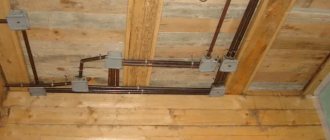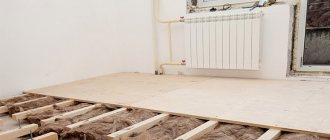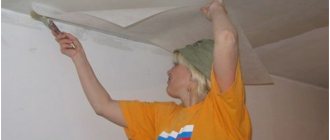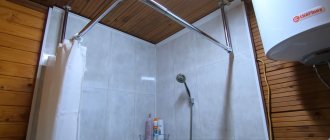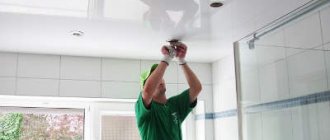Subfloors have several types depending on their purpose and installation method. First, you should consider their features and differences, and then talk in detail about the construction method. As always, we will use an example to consider the most complex option; if it becomes clear, then it will be much easier to make simpler subfloors.
Example of a subfloor in a wooden house
Kinds
The most common option for a subfloor in a frame or wooden house (or “black”) is to create a durable flooring supported by beams. But for the first floor it is also possible when the logs are installed on a reinforced concrete slab floor on a strip foundation, on a shallow foundation slab or on a concrete floor on the ground. The last three options are not fundamentally different from each other, although in all cases the methods of fastening and leveling the logs horizontally are different.
Since the concrete base itself is strong and reliable, it can be considered as the “underlying” part of the floor of the lower floor (according to the regulatory terminology SNiP 2.03.13-88). In this case, it remains to equip only the “leveling” part (wet, dry or prefabricated screed) and the “intermediate” part (heat, vapor and waterproofing). And lay the finishing coating over the leveling part.
Concrete floors laid on the ground are another common option Source remontik.org
The subfloor is only part of the wooden floor. It is made from edged boards and sheets of moisture-resistant wood materials. The thickness of the flooring (board or sheet) and the layout of the logs have a “direct” relationship: less thickness means less interval between runs.
Important! If we are talking about boards, then when laying diagonally (for example, in rooms with complex geometry), the pitch of the lag should be even smaller. Moreover, the angle between the board and the purlin must be greater than 45°.
Wood flooring is the top layer of the cake. Layer by layer the entire structure looks like this:
- Lining . It does not affect the load-bearing properties of the ceiling, but acts as a support for insulating materials.
The thickness of the lining must be sufficient to support the weight of the insulation Source doma-na-veka.ru
- Waterproofing . Membrane type materials are used. They do not allow water to pass through, but allow water vapor to erode from the insulation, which then exits through the vents in the basement (plinth) of the foundation.
- Thermal insulation . Usually these are mineral wool mats, which, unlike polystyrene foam, are non-flammable materials.
- Vapor barrier . There are three types in total. Films with limited vapor permeability that maintain a “balance” between moisture transfer from the room into the insulation and from the insulation to the outside. Vapor-tight films are a vapor barrier that almost completely excludes the penetration of warm air with water vapor into the insulation. Foil materials (reflex films) are a vapor barrier that returns some of the heat back into the room. All three types, as befits a vapor barrier, have waterproof properties that protect the insulation from above, from the side of the room, from water ingress.
- Flooring.
A multilayer sheet of plywood for the subfloor will withstand heavy loads Source yug-energo.ru
See also: Catalog of companies that specialize in the design and construction of turnkey country houses.
Laying lag along the bottom trim
Before installing logs, the wood must be treated with special coating materials. The logs are primed and coated with antiseptics in several layers. Each layer must dry thoroughly. If the joists have an uneven shape with protruding bumps, they should be processed. The horizontality of the bars will subsequently affect the installation of the flooring. It depends on this whether the coating will be smooth or with differences. Having prepared the logs, you can begin their installation.
Installing floor joists involves cutting grooves in the bottom frame of the building structure. The bottom frame is a layer of beams that lie on the foundation and serve as the basis of the entire room. This is a kind of frame on which the house stands. It is in this frame that the grooves for the joists should be cut.
The ends of the treated beams are inserted into the prepared recesses. Many craftsmen advise rubberizing the joints of the joists and grooves to prevent the accumulation of moisture and the appearance of microorganisms. Of course, a heavy long beam will bend without any support along its length. In this regard, it is necessary to prepare pillars for the logs.
It is recommended to make support posts from brick. To do this, you need to dig a recess, the base of which is carefully compacted. Either gravel or crushed stone is poured into the hole. The topping layer should also be compacted. Then sand of any type is poured. All layers are compressed. Next, the cement-sand mixture is poured, the base should dry well. This stage is similar to laying the base of a concrete floor.
A construction cushion is created and cement is poured onto it. If desired, the filling can be accompanied by the installation of reinforced mesh. As soon as the cement has dried, a layer of rolled material is laid on it. It can be roofing felt or other material, it all depends on the preferences of the owner. The support pillar is laid on the insulation layer. The attachment point for the support and joist is waterproofed. This measure is necessary to prevent moisture from entering the wood structure.
Thus, the service life of the structure will increase significantly, the logs will not rot or collapse. The distance between the beams is calculated based on the thickness of the plank base. The thinner the board, the more frequent the step between the lags and, vice versa. This nuance should be taken into account at the planning stage of laying the rough structure. After completing the installation of the beams, it is necessary to secure them together. This measure helps to secure the frame; if this is not done, the logs will begin to “walk.”
Device options
There are two main filing options:
- Under the beams . The disadvantage of this method is that in the subfloor of the house there is often not enough “space” to carry out the fastening procedure. The advantage is that almost the entire volume between the beams can be used for insulation. Only when reflective vapor barrier materials are laid should a small gap be left between the film and the flooring.
Fastening to each beam, on both sides of the “opening”, cranial bars - a lining is mounted to them. The most common and easy to implement method. The disadvantage is that the insulation layer will be less than the thickness of the skull block plus the lining.
This is what the floor plan with filing to the cranial block looks like Source derevyannyydom.com
- On top of the beams . Disadvantage - the height of the logs is chosen greater than the thickness of the insulation. As an option, it is possible to lay an additional counter-lattice on top of the logs for another layer of thermal insulation.
In principle, such a complex ceiling device is only necessary for a heated residential building. In a garden or country house for seasonal use, you can limit yourself to only wooden flooring without filing and insulation, although waterproofing in this case must also be laid to protect the wood from moisture.
Important! All wooden elements, from the sheathing to the flooring, must be impregnated with antiseptics and fire retardants. And after sawing and drilling, the ends must be treated again with these compounds using a brush.
Fire and bioprotection is a mandatory stage in the processing of wood working in extreme conditions Source derevovdom.ru
How to lay an array with your own hands
The solid board is laid on plywood sheets. The base can be either a concrete floor or a wooden floor on joists.
- It is necessary to measure 15 mm from the walls to create a ventilation gap and in case of seasonal deformations.
- The finished floor boards must be laid so that they are located across the subfloor boards. The first row is placed with a tenon to the wall and screwed with self-tapping screws. It is necessary to tighten the screws so that they are covered by the baseboard near the wall. On the second side, the screws are screwed into the groove at an angle of 45°.
- A wooden spacer is placed in the gap between the board and the wall. If the size of the room is greater than the length of the floorboards, then the boards are laid “staggered”. This will make the floor more durable.
- The second and subsequent rows of boards are laid with a tenon in the groove of the previous row, compacted with a mallet and fastened with self-tapping screws on the other side into the groove. If you want your wooden floor to last as long as possible, you need to lay the boards in such a way that the growth rings are located opposite each other.
The parquet board is laid "staggered". Solid parquet boards can also be used as a finished floor. In essence, this is the same tongue-and-groove solid board, only shorter. Its installation is slightly different:
- Can be fixed with self-tapping screws only from the tenon side.
- Installation is carried out only “staggered”.
- If the base is made of plywood, then it is better to glue the parquet board first and then additionally secure it with self-tapping screws.
- If you lay the board diagonally, the room will visually look larger.
Material requirements
The following materials are usually chosen for flooring :
- edged board;
- waterproof plywood;
- Fiberboard or chipboard with waterproof treatment;
- OSB plate;
- cement particle board (CSB) or GVL.
Recommended ratio between board thickness and joist layout Source semanticscholar.org
Plywood is stronger due to its multi-layer structure, and it is much thinner for a subfloor.
Wet installation method
Floor screed. This method is quite common, since the materials are relatively inexpensive and are always on sale.
They are performed as follows:
- The base is cleared of debris. Lay hydro and thermal insulation.
- Beacons - special steel slats - are attached in increments of 2 m. With their help, the horizontal screed is maintained.
- Apply the prepared solution in portions and level it using a rule and a trowel.
- A topcoat is required if the finished floor is made of delicate materials. Most often, self-leveling mixtures up to 15 mm thick are used.
Self-leveling floor. This is the name of a subfloor when roughing and finishing screed are performed in one process.
A fluid solution is poured onto the prepared base (cleaned and primed) and leveled with a special needle roller, which removes air bubbles.
The thickness of such a cement-polymer floor is from 0.5 to 3 mm, therefore the drying time is much less than that of a cement screed - from several days to two weeks.
Classic scheme
A feature of the classic scheme is the significant distance between the beams.
Typically, the layout step is 0.8-1 m, and this is “reflected” in the choice of board thickness.
This is what a “powerful” log house floor looks like Source ukrasheniyedoma.com
A typical subfloor structure looks like this:
- timber with a section of 15x15 or 15x20 cm;
- cranial block with a cross section of 4x4 cm;
- hemming with a board 2.0 cm thick (can be unedged, but cleared of wane) or plywood 1.5 cm thick;
- waterproofing (glassine, polymer membrane);
- insulation (stone wool) no more than 10 cm thick - this is all that the remaining volume between the beams allows after installing the cranial block with filing;
- vapor barrier;
- board 4.5-5.0 cm thick.
And now this design is used, but it no longer meets modern requirements for thermal protection. Therefore, a counter-lattice is mounted on top of the beams, between which another layer of thermal insulation is laid.
Another advantage of this method is that the layout of the logs can be reduced to 30-40 cm, and subfloor boards can be chosen with a thickness of 20-24 mm.
Scheme of complex insulation of a frame house with a double thermal insulation contour of the floor and mesh as a backing Source obustroeno.com
The modern scheme for laying a subfloor for a wooden house is more advanced and allows you to insulate the floor without additional “superstructures” in the form of a counter-lattice:
- Boards placed on edge . Fixed to the beam, and, if necessary, supported by intermediate supports, they act as logs. The thickness of the board is 5 cm, and the width is at least 20 cm. The layout step can be made 60 cm (to match the width of the stone wool rolls), and in terms of wood consumption for purlins, this option is more economical than the classic scheme.
- Polymer (wire mesh) for supporting waterproofing and insulation.
- wind and waterproofing film . Allows excess moisture to evaporate, protects the insulation from water ingress and weathering of fibers.
- Stone wool in the form of semi-rigid mats 20 cm thick.
- Vapor barrier.
- Flooring made of boards 36 mm thick.
The only drawback of the modern scheme is the poor stability of the lag. This is due to the large difference between the width (the supporting part) and the height. To ensure the stability of the structure, additional transverse braces are used that “connect” the logs to each other and to the frame (grillage).
Typical ceiling of the first floor of a frame house made of boards on the “edge” Source stranapap.ru
The advantages of the scheme are obvious - savings on lumber (in “volume” equivalent) and a simple one-layer insulation scheme.
Board size and thickness
The dimensional parameters of the finished floorboard are no less important, because the main load falls on the outer covering. Today on the market there are boards with a width from 80 to 135 mm, the most popular sizes are 100-105 mm. The thickness of the floorboards can be selected from the following sizes: 28, 30, 32, 35 and 40 mm, but most often they choose 30, 32 and 35 mm. When choosing the length, you should focus on the largest size of the room. It is advisable that one floorboard extends lengthwise across the entire room. The length of the floor boards can be 3; 4; 4.5 and 6 meters.
It is not recommended to install lumber with a thickness of less than 22 mm; such a coating will sag over time, and its elements will quickly fail. The quality of wood for external flooring plays an important role, so you should choose the best grade of floorboards with a minimum number of defects.
Subfloor of the second floor (attic) or cold attic
There are no living rooms under the wooden floor of the first floor, so “simple” materials can be used for lining without finishing or decorative surface treatment. The interfloor ceiling is hemmed from below with planed boards or clapboard.
And although insulation of the floor between heated floors is not required, mineral wool is placed between the joists. In this flooring pie it acts as sound insulation. Ideally, you should use acoustic wool. It differs from the usual one in its “chaotic” fibrous structure. But heat-insulating modifications can also be laid - with the same thickness and density, their sound absorption coefficient is only 10-15% lower than that of acoustic ones.
The ceiling of a cold attic must be insulated.
Installation of a cold attic ceiling begins with attaching a vapor barrier Source legkovmeste.ru
And since in a low-rise building even an “uninhabited” attic is used, the insulation must be covered with a subfloor (but without further finishing).
The ceiling diagram of a cold attic looks like this (from bottom to top):
- false ceiling of the underlying heated floor;
- vapor barrier laid in a continuous and continuous layer with sealing tape along the entire perimeter of the ceiling;
- insulation between beams (lag);
- membrane-type waterproofing laid on the surface of stone wool;
- spacer bar stuffed onto the beams, providing a ventilation gap;
- attic subfloor.
Important! The layer-by-layer structure does not reflect the installation sequence. At the first stage, a vapor barrier film is attached to the bottom of the floor beams. And on top of it, a block is mounted on the beams, to which the sheathing for the false ceiling is attached. If you first hem the boards, the film will have to be laid on top of the beams. In this case, water vapor will penetrate into the wood, but there will be nowhere for it to erode, which will lead to wetness of the floor beams and create conditions for their rotting.
Nuances of technology
The subfloor allows the use of decorative floor covering material that does not have self-supporting properties, rigidity and resistance to bending loads. The main difficulties arise with the installation of partitions and remote consoles.
Partitions and walls
To ensure the operational life of the partitions, their installation should be carried out along the floor beams. If an internal non-load-bearing wall passes between the beams, they must be reinforced with jumpers made of boards or bars according to the diagram below. In order for the subfloor wood to withstand the loads, the following conditions must be met:
- jumper spacing within 1.2 m;
- The minimum section of the bar is 40 x 90 mm.
Important! Jumpers are not needed if the partitions run perpendicular to the beams.
The internal main wall of a wooden cottage must rest on the lower wall or floor purlin. It can be shifted by 0.6 m in any direction relative to the support unit of the floor beam between floors and by 0.9 m in the attic.
Reinforcement under partitions.
Subfloor under tiles
The technology of how to properly make the subfloor of a wooden house for laying tiles has its own characteristics if a board is chosen for the flooring.
Tiles in a wooden house in some rooms are simply necessary due to the nature of their use Source et.aviarydecor.com
Unlike wood, ceramic tiles do not change their linear dimensions with changes in humidity levels. Moreover, wood reacts differently to such differences in the directions along and across the fibers. And to compensate for these changes, a “damper” layer must be laid on top of the boards.
Plywood or moisture-resistant plasterboard is chosen as the top layer of the leveling part of the subfloor. Although plywood is made of wood, it does not change its linear dimensions due to its multi-layer structure with multi-directional arrangement of fibers in each layer. But we must take into account that both materials are subject to deformation during prolonged contact with water or when used in a room with a “wet” regime. And in such areas, before laying the tiles, you need to make another waterproofing layer.
Mounting methods
All subfloors can be divided according to the method of fastening the supporting structure:
- attached to walls;
- installed on a concrete base;
- ground mounted;
- combined.
Fastening the load-bearing structures of the subfloor to the walls is most in demand in houses installed on screw, columnar and strip foundations. Read more about different types of foundations in the article - Which foundation is best for a house made of timber - calculation features. This method of fastening allows you to create a rigid load-bearing floor frame, but requires a lot of wood consumption. The most popular mounting methods are using corners and in a cut-out groove. The first method is simpler, but less reliable, the second method is more reliable, but involves cutting through one of the crowns.
When installing a floor on a concrete base, various supports are used that allow you to raise the logs above the concrete. Brick pedestals and metal fasteners are used as supports. It is also possible to lay the logs directly on concrete, but in this case it will be necessary to carry out very high-quality waterproofing. In some wooden houses, the floor supports are installed on the ground. In this case, brick pedestals are built as supports. The combined method of attaching the load-bearing structure of the floor involves the use of the methods described above in any combination.
Plate
If a wooden house stands on a slab (foundation or ceiling on a brick plinth), then the floor of the first floor is equipped with a screed. In this case, the same technologies are used as in stone houses.
On a solid base, logs can even be installed on point adjustable supports Source pinterest.it
Even for installing a wooden subfloor, there is a choice among a wider list of methods:
- installing joists on supports on a concrete base without fixing them to the base and load-bearing walls (floating floor);
- installation of logs on adjustable supports;
- installation of adjustable plywood.
Design Features
At the base of the floor on wooden logs are beams (joists). These are beams made of wood or polymer materials, laid parallel to each other, which serve as support for the sheet material. This is one of the most common options for creating a subfloor.
It is distinguished by:
- sufficient ease of installation;
- low cost of material;
- significant increase in floor strength;
- uniform load distribution;
- ease of installation of thermal insulation and noise protection.
It is impossible not to note the versatility of this type of subfloor
Logs can be laid on the ground, wooden or concrete surfaces; of course, in all cases it is important to ensure maximum protection of the wood from moisture. The result of work done correctly will be a dry, ventilated subfloor, which will have a positive effect on the characteristics of the floor and the structure as a whole.
Wood selection
Repairing the foundation along beams involves using only high-quality and durable wood that can withstand large static and dynamic loads over a long period. That is why in the process of choosing logs you need to take into account the following parameters:
- Section. The minimum cross-section of logs for floors in private houses is 15 by 15 cm;
- Dimensions. In the process of laying beams into “sockets”, it is desirable that the distance between them and the wall is at least 10-15 mm;
- Tree species. For installation of floors, larch of the 2nd or 3rd grade is suitable;
- Humidity. The maximum moisture content of materials can only be 12-15%. Since wood absorbs moisture, additional treatment of the logs with antiseptics will be required when laying the floor.
